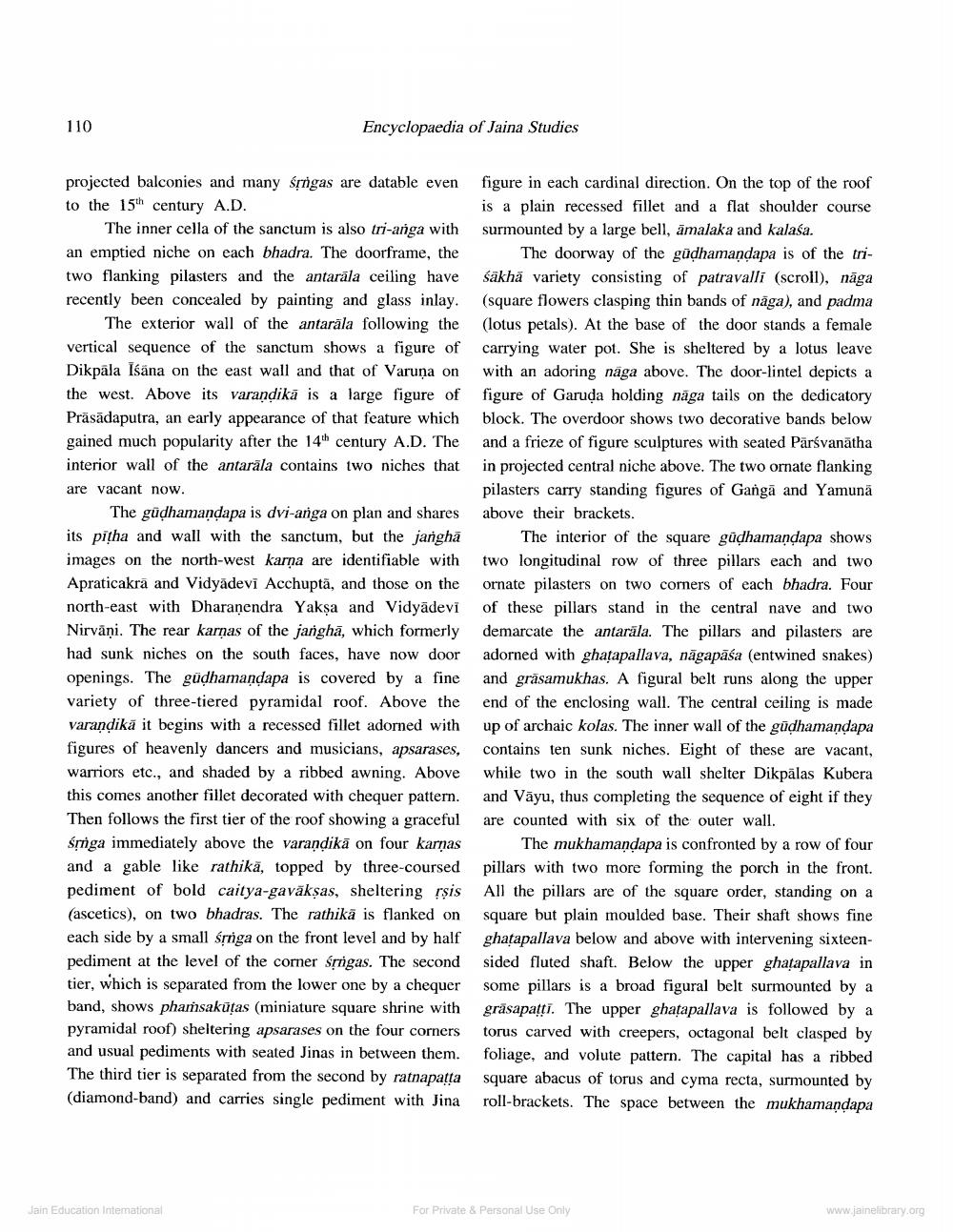________________
110
Encyclopaedia of Jaina Studies
projected balconies and many śľngas are datable even to the 15th century A.D.
The inner cella of the sanctum is also tri-anga with an emptied niche on each bhadra. The doorframe, the two flanking pilasters and the antarala ceiling have recently been concealed by painting and glass inlay.
The exterior wall of the antarāla following the vertical sequence of the sanctum shows a figure of Dikpala Isäna on the east wall and that of Varuņa on the west. Above its varandikā is a large figure of Prāsādaputra, an early appearance of that feature which gained much popularity after the 14th century A.D. The interior wall of the antarala contains two niches that are vacant now.
The gūdhamandapa is dvi-anga on plan and shares its pitha and wall with the sanctum, but the jangha images on the north-west karna are identifiable with Apraticakra and Vidyadevi Acchupta, and those on the north-east with Dharanendra Yaksa and Vidyādevi Nirvani. The rear karnas of the jangha, which formerly had sunk niches on the south faces, have now door openings. The güdhamandapa is covered by a fine variety of three-tiered pyramidal roof. Above the varandikā it begins with a recessed fillet adorned with figures of heavenly dancers and musicians, apsarases, warriors etc., and shaded by a ribbed awning. Above this comes another fillet decorated with chequer patter. Then follows the first tier of the roof showing a graceful śrriga immediately above the varandikā on four karnas and a gable like rathikā, topped by three-coursed pediment of bold caitya-gavākṣas, sheltering rșis (ascetics), on two bhadras. The rathikā is flanked on each side by a small śrga on the front level and by half pediment at the level of the corner śrrigas. The second tier, which is separated from the lower one by a chequer band, shows pharsakütas (miniature square shrine with pyramidal roof) sheltering apsarases on the four corners and usual pediments with seated Jinas in between them. The third tier is separated from the second by ratnapatta (diamond-band) and carries single pediment with Jina
figure in each cardinal direction. On the top of the roof is a plain recessed fillet and a flat shoulder course surmounted by a large bell, amalaka and kalasa.
The doorway of the güdhamandapa is of the trisākha variety consisting of patravalli (scroll), nāga (square flowers clasping thin bands of nāga), and padma (lotus petals). At the base of the door stands a female carrying water pot. She is sheltered by a lotus leave with an adoring någa above. The door-lintel depicts a figure of Garuda holding näga tails on the dedicatory block. The overdoor shows two decorative bands below and a frieze of figure sculptures with seated Pārsvanātha in projected central niche above. The two ornate flanking pilasters carry standing figures of Gangā and Yamuna above their brackets.
The interior of the square gūdhamandapa shows two longitudinal row of three pillars each and two ornate pilasters on two corners of each bhadra. Four of these pillars stand in the central nave and two demarcate the antarala. The pillars and pilasters are adorned with ghatapallava, nägapāśa (entwined snakes) and grasamukhas. A figural belt runs along the upper end of the enclosing wall. The central ceiling is made up of archaic kolas. The inner wall of the gūdhamandapa contains ten sunk niches. Eight of these are vacant, while two in the south wall shelter Dikpālas Kubera and Vāyu, thus completing the sequence of eight if they are counted with six of the outer wall.
The mukhamandapa is confronted by a row of four pillars with two more forming the porch in the front. All the pillars are of the square order, standing on a square but plain moulded base. Their shaft shows fine ghatapallava below and above with intervening sixteensided fluted shaft. Below the upper ghatapallava in some pillars is a broad figural belt surmounted by a gräsapatti. The upper ghatapallava is followed by a torus carved with creepers, octagonal belt clasped by foliage, and volute pattern. The capital has a ribbed square abacus of torus and cyma recta, surmounted by roll-brackets. The space between the mukhamandapa
Jain Education Intemational
For Private & Personal Use Only
For Private & Personal Use Only
www.jainelibrary.org




